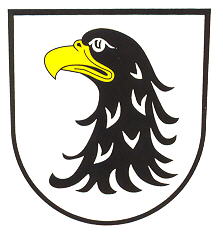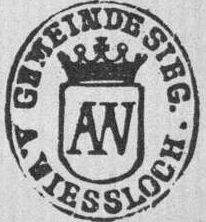Altwiesloch: Difference between revisions
Knorrepoes (talk | contribs) m (Text replacement - "{{media}}" to " {{de1}} {{media1}}") |
Knorrepoes (talk | contribs) m (Text replacement - "{{de}}" to "") |
||
| Line 1: | Line 1: | ||
'''ALTWIESLOCH''' | '''ALTWIESLOCH''' | ||
Revision as of 14:47, 26 December 2022
ALTWIESLOCH
State : Baden-Württemberg
District (Kreis) : Rhein-Neckar Kreis (until 1973 Heidelberg)
Incorporated into : 1908 Wiesloch
| German |
In Silber ein schwarzer Geierkopf mit goldenem Schnabel. |
| English | No blazon/translation known. Please click here to send your (heraldic !) blazon or translation |
Origin/meaning
The arms were officially granted in 1898.
Altwiesloch developed as a village in the 18th century around the local (12th century) castle. The village belomged to Wiesloch until 1842 when it became a separate municipality. In 1908 it was again merged with Wiesloch.
The oldest known seal of the village is known since 1759 and shows the lion of the Pfalz (to which the region belonged at the time) with the letters A and W. After 1842 the village simply used the letters AW, without the lion.
| The arms on a municipal stamp (1892) |
At the end of the 19th century the State Archives of Baden proposed the above arms, with a vulture's head derived from the arms on a seal of Heinrich Schwedinger von Wiesloch from 1245. The Von Wiesloch family were the first owners of the castle around which the village developed. The vulture was used as a crest on the arms of the Von Wiesloch family. As no colours were known they were arbitrarily chosen.
Even though the arms are more looking like an eagle's head, they are described as a vulture.
Literature: John and Wüst, 1996

